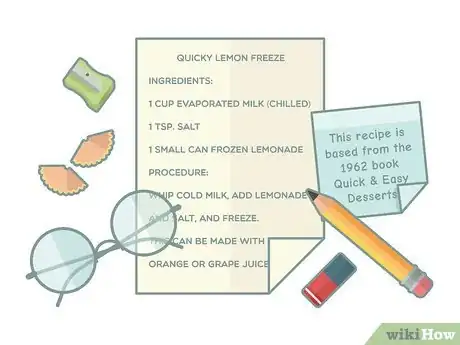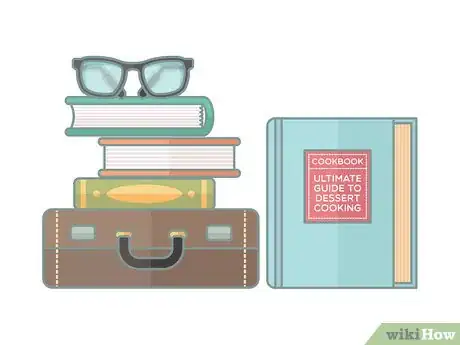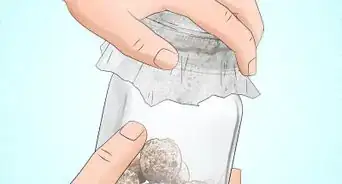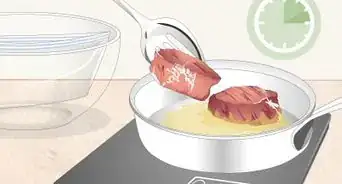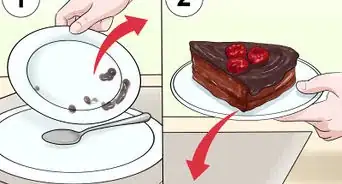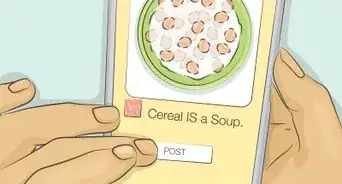This article was co-authored by Zachary Green and by wikiHow staff writer, Jessica Gibson. Zachary Green is an Entrepreneurship Coach, Author, and U.S. Marine Corp Veteran. With over 10 years of experience as an entrepreneur, he specializes in helping people transform their businesses, relationships, and lives. Zachary’s book, Warrior Entrepreneur, focuses on how warrior traits can help entrepreneurs, leaders, and others battle through adversity and accomplish their missions. Zachary was featured in Entrepreneur Magazine, on the front page of Yahoo.com, MSN.com, and in USA Today, along with numerous other local and national media outlets, and was named Entrepreneur of the Year by Governor John Kasich. Zachary was also selected by the Obama White House as one of 10 entrepreneurs to represent the United States at the Global Entrepreneur Summit. He was also featured in the US Playing Cards Frontline Leaders playing card series as one of 52 veteran entrepreneurs. Zachary earned a BA in Marketing and Sports Management from Bowling Green State University in Ohio. He won the Ohio Chamber of Commerce Entrepreneur of the Year in 2013, the SBA Ohio Small Business Exporter of the Year in 2016, a Spartan Distinguished Alumni Award in 2017, and a President’s E Award in 2019.
There are 8 references cited in this article, which can be found at the bottom of the page.
wikiHow marks an article as reader-approved once it receives enough positive feedback. This article received 20 testimonials and 100% of readers who voted found it helpful, earning it our reader-approved status.
This article has been viewed 298,822 times.
Writing a cookbook is often a dream of the avid home cook. And why not? Recipes are a treasure trove of experience, history, and love all rolled into one. Start with a broad idea of what you'd like your cookbook to be about. Organize and refine the recipes that you want to use in the book and have people test your recipes. Once you're happy with your cookbook, find an agent or publishing company to produce your cookbook. Or consider self-publishing your cookbook or ebook.
Steps
Organizing the Cookbook
-
1Choose the focus or theme of the cookbook. If you want to write a cookbook, chances are you already have a general idea of what you want to write about. Start with a broad style of food or specific type of diet. From there, you can begin to narrow down exactly what you'll write about.
- For example, you might want to write a dessert cookbook or a party food and appetizer cookbook.
-
2Find your niche. Once you've chosen a broad theme, narrow down the focus of your cookbook so it really stands apart. While lots of new cookbooks are published every year, you'll increase the chances of being published if you make yours stand out from the others. If you have a unique take on a cooking style or food, you might want to make that the focus of your cookbook.[1]
- For example, your dessert cookbook could contain recipes on how to make sophisticated s'mores. Or the party and appetizer cookbook could focus on foods that are paleo-diet friendly.
- Finding your niche also involves finding your audience. Ask yourself, “Who would purchase this book?” before you start writing.
Advertisement -
3Decide if you're writing the cookbook for personal or professional use. If you'd simply like to write a cookbook for your own use in the kitchen or to give to family and friends, you can be more casual with the writing, photo quality (if you even take pictures), and structure of the book. If you want to write a cookbook to be published, you'll need to make the book as polished, creative, and original as possible.
- To make a personal cookbook, you can write it up on your computer in a readable PDF file. Print the file and have it bound at a copy or printing place.
-
4Research what's popular. If you're struggling to narrow the scope of your cookbook, you might want to contact a few publishing companies. Briefly tell the publishing company that you're writing a cookbook and you'd like to know if the publishing company is actively looking for specific types of cookbooks. You can also check popular websites for new food trends, products, or diets.[2]
- Remember that you'll want your cookbook to stand out, so you might even want to combine a few popular combinations (like how to ferment spiralized foods or make gluten-free cake pops).
-
5Decide the style of the cookbook. Once you've narrowed down the scope of your cookbook, decide the mood and feel of the book. Determine if you'd like to simply give recipes or if your cookbook will also tell a story. A narrative might help to make your cookbook stand out from others, especially if it has a broad theme.[3]
- For example, if you're writing about cooking for a family, you can add interest about writing about what makes your family unique. For example, tell stories about cooking for your large family, your family with several dietary restrictions, or cooking a specific style of food for your family on a budget.
-
6Create a rough outline of the contents. Before you begin to assemble recipes, decide on a loose outline of the cookbook. This way, you'll be able to plug recipes into their chapters or tell a story along with the recipes. If you're having trouble with an outline, look through some of your favorite cookbooks to get organizational ideas.
- For example, your dessert cookbook might have 4 chapters: one on classic cake pops, one on gluten-free cake pops, one on shaped cake pops, and one on savory cake pops.
- While it's okay to be slightly quirky, remember that readers usually expect standard cookbooks to be arranged from savory to sweet, starters to mains to dessert, or from inexperienced cook to skilled in the kitchen.
Creating Original Content
-
1Gather your own recipes. Examine all the recipes you have on your cookbook theme. Sort through them for recipes that you think taste the best and that you'd like to include in the cookbook. Select 10 to 15% more recipes than you plan on putting in the cookbook. Avoid including recipes that you have had trouble making or aren't passionate about.[4]
- Think about the recipes that you've made for other people. If any of them were a big hit, include them in the cookbook.
-
2Make the recipes and write down tips. Test more recipes than you think you'll need, since you may change your mind about using some of them. As you test, write very detailed descriptions of how to make each recipe. Include helpful tips to encourage your readers to make the food. Try to give substitutions for ingredients and variations for the recipes.[5]
- For example, instead of saying, "Cream the butter and sugar," instruct your readers to, "Beat room temperature butter with the sugar on medium speed until it's light and fluffy."
- Ask other people to test your recipes. This way you can get feedback about how clear your instructions were, how the food tasted, and where you need to improve the recipe.
-
3Write each recipe as you want it to appear in the cookbook. Read over all of the testing notes and any feedback you got from others. Create a detailed recipe by explaining how to cook or assemble the ingredients. Be as clear and thorough as you can so people of many skill levels can cook your food.
- Diagrams and illustrations may be as helpful as photos in some cases. If you can't draw, find someone who is willing to help out.
-
4Take photographs of the food. High-resolution, quality photos help the reader imagine the end result of a recipe and inspire them to make the dish. Decide if you'd like to take a photo for every recipe or just include a few for each chapter. If your photography skills need brushing up, take a quick class or learn how to use photo-editing software to edit the pictures.[6]
- You can also hire a photographer to photograph your food, but this will add to the cost of making your cookbook.
-
5Give proper credit to others. All the recipes in your book should be written by you or at least changed in some way to make them your own. While lists of ingredients and very basic recipe instructions are not covered by copyright, the words used to describe the methods in each step or as a whole are copyright. If you've changed a recipe from another person, give them credit for the recipe.
- For example, if you've made a few small changes to someone's recipe, note that your recipe was adapted from this person's recipe. If you've made larger changes to the recipe, you could say that your recipe was inspired by this person's.
- Never use someone else's photography or illustrations since these are protected by copyright.
Publishing the Cookbook
-
1Hire an editor to proofread your work. Edit your work several times and have others read through it as well. Check for accuracy of ingredients, measurements, cooking times, etc. Readers will expect your recipes to turn out the way you describe, so if a step is missing or inaccurate, you may lose readers.[7]
-
2Find an agent. While you don't have to have an agent before you submit a cookbook proposal to a publisher, having an agent can greatly improve your chances. Look at several of your favorite cookbooks and read through the acknowledgements. The author should mention their agent. Contact the agent and send them a brief message about working with them.[8]
- Send inquiries to a few agents since many will be busy or might have cookbook projects that are similar to your own.
-
3Contact publishers. Your agent will send information about your cookbook to several publishing houses. If you don't have an agent, you'll need to decide which publishers to send your cookbook or proposal to. If publishers are interested in your cookbook, they'll talk with you about the overall look (photography, gloss or matte finishes, cover art) of the book and publishing fees and profits.[9]
- Don't be surprised if publishing houses will ask you to make changes to the structure or content of your cookbook. This may be because they want your cookbook to really stand out or be easier to market.
-
4Create a following on social media. Many traditional publishers will be more likely to work with you if you already have lots of people interested in reading your book. Try to create a food blog that highlights some of your best work and has lots of readers. Give the publishers information about how many regular visitors you have to your blog as well as how many unique views you get each month.
-
5Consider paying to self-publish your cookbook. If you can't find a publishing company or want to make all of the publishing decisions yourself, you can self-publish your book. Contact a company that will publish your cookbook and discuss costs associated with printing the book.[10]
- If you want to offer a cookbook to readers on your blog, you may want to publish an ebook. These are simply files that your readers can pay to download. You won't need to publish an actual hard copy of your cookbook if you do an ebook.
Community Q&A
-
QuestionWhat is a minimum number of recipes needed to put in a cookbook?
 Community AnswerThere's no set amount of recipes needed for a cookbook. Create as small or as large of a cookbook as you like. In many cases, your publishing company will tell you how many recipes they'd like to see included in your book.
Community AnswerThere's no set amount of recipes needed for a cookbook. Create as small or as large of a cookbook as you like. In many cases, your publishing company will tell you how many recipes they'd like to see included in your book. -
QuestionCan I use pictures from other people for my cookbook?
 Community AnswerIn order to use another person's pictures, you must have their written permission. In this case, the images cannot be images that are easily available online. They must be original works.
Community AnswerIn order to use another person's pictures, you must have their written permission. In this case, the images cannot be images that are easily available online. They must be original works. -
QuestionCan the internet be my source for recipes?
 Community AnswerYou'll need to create your own recipes to publish in your cookbook. If you're adapting or changing recipes that you've found online, always give credit to the original recipe and write the method in your own words.
Community AnswerYou'll need to create your own recipes to publish in your cookbook. If you're adapting or changing recipes that you've found online, always give credit to the original recipe and write the method in your own words.
References
- ↑ https://www.mediabistro.com/climb-the-ladder/skills-expertise/cookbook-writer/
- ↑ http://www.davidlebovitz.com/writing-your-ow/
- ↑ http://www.telegraph.co.uk/food-and-drink/features/diana-henry-how-to-write-a-cookbook/
- ↑ http://blog.ice.edu/2014/09/12/so-you-want-to-write-a-cookbook-part-iv-getting-down-to-work/
- ↑ https://cookieandkate.com/2017/how-to-write-a-cookbook/
- ↑ http://blog.ice.edu/2014/09/12/so-you-want-to-write-a-cookbook-part-iv-getting-down-to-work/
- ↑ http://www.writershelper.com/editor-cost.html
- ↑ http://www.davidlebovitz.com/writing-your-ow/
- ↑ http://greenapron.com/2016/10/steps-to-write-a-cookbook-find-an-agent-or-publisher/
About This Article
To write a cookbook, start by choosing a theme or focus for the book, like desserts or vegetarian recipes. Then, gather a bunch of different recipes and test them out to see which ones you want to include in your cookbook. As you test the recipes, take detailed notes so it's easier to describe how to make them later on. Next, write out your recipes and take high-resolution photos of the food so you can add pictures to your cookbook. Once you're finished with the content, you can start reaching out to agents and publishers! To learn how to get your cookbook published, scroll down!










